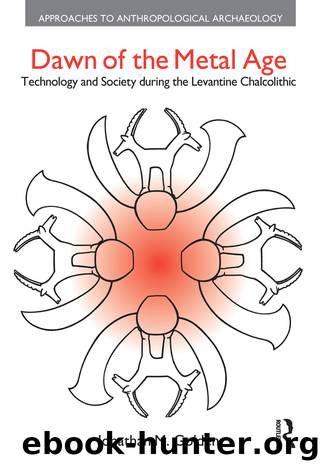Dawn of the Metal Age by Jonathan M. Golden

Author:Jonathan M. Golden [Jonathan M. Golden]
Language: eng
Format: epub
Publisher: Routledge
By addressing these questions, each of which pertain to various stages or facets of the metallurgical process, we can attempt to reconstruct the entire process of copper production.
Raw Material: Ore and Fuel
The first step in any metallurgical process involving smelting is the selection of ores. Thus, any study on an ancient metallurgical system might begin with questions about the ore—what types, where from, how much—discovered at production sites. Answering these questions entails describing and characterizing the ores based on chemical analysis and microscopic examination of the artifacts, or in the case of ore, 'geofacts'. This in turn requires an understanding of where this material derives from, calling for provenance studies, where the ore found in archaeological contexts at production locales far away from mines (e.g. at village sites), are compared with the material from known sources. While such studies cannot provide precise answers about sources with absolute certainty, they can be used to make fairly accurate predictions.
There are several different approaches that may be employed in the analysis of ores, Bulk chemical analysis yields information about the overall composition of material, which can be used for direct comparison with quantitative data from known ore sources. It is also necessary to study the structure—macrostructure and microstructure—of the ore in order to determine the types of mineralizations from which the ores originate, and to give the best indication of what types of ores were selected.
The types of ore found at the Negev sites include malachite, (par)atacamite, chrysocolla (the secondary Cu-minerals) as well as 'tile' ores, a mixture of cuprite and limonite named for their brick red color. Chalcocite and covellite, the copper sulfides, also appear, though less frequently. Also common are the 'brecciated ores' where cuprite (tile ore) is intermixed with malachite and other green secondary copper minerals, producing a marble-like effect.
Although multiple factors determine the outcome of the smelting reaction, the composition of the ore will ultimately have the greatest bearing on the composition of the slag, the byproduct of the smelting process. The most important characteristic of the Chalcolithic ore is the high copper content: of the ores analyzed in this study, not one contained less than 42% copper (see Table 7.1). This is obviously a critical factor when we attempt to understand the extractive process. For once it became possible to generate temperatures of at least 1200° C and to produce a reducing atmosphere, extracting metallic copper from these ores became much easier.
Table 7.1 a) Chemical composition of ores from Chalcolithic sites in the northern Negev; BAM= Abu Matar; BES= Bir es-Safadi; SQ.MA= Shiqmim; NT= Nahal Tillah 79. b) Chemical composition of slags from Chalcolithic sites in the northern Negev; BAM= Abu Matar; BES= Bir es-Safadi; SQ.MA= Shiqmim.
Download
This site does not store any files on its server. We only index and link to content provided by other sites. Please contact the content providers to delete copyright contents if any and email us, we'll remove relevant links or contents immediately.
Learning SQL by Alan Beaulieu(6237)
Weapons of Math Destruction by Cathy O'Neil(6215)
Digital Minimalism by Cal Newport;(5704)
iGen by Jean M. Twenge(5385)
Sapiens by Yuval Noah Harari(5322)
The Age of Surveillance Capitalism by Shoshana Zuboff(4245)
Elon Musk by Ashlee Vance(4084)
Thing Explainer by Randall Munroe(3910)
Apollo 8 by Jeffrey Kluger(3667)
Future Crimes by Marc Goodman(3563)
The Science Book (Big Ideas Simply Explained) by DK(3253)
Who Can You Trust? by Rachel Botsman(3111)
The Innovators: How a Group of Hackers, Geniuses, and Geeks Created the Digital Revolution by Walter Isaacson(2994)
I Live in the Future & Here's How It Works by Nick Bilton(2960)
Infinite Energy Technologies by Finley Eversole(2953)
Steve Jobs by Walter Isaacson(2858)
Dawn of the New Everything by Jaron Lanier(2751)
Chernobyl by Serhii Plokhy(2514)
Ben Franklin's Almanac by Candace Fleming(2492)
